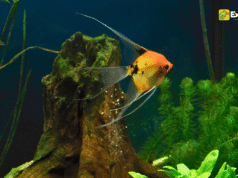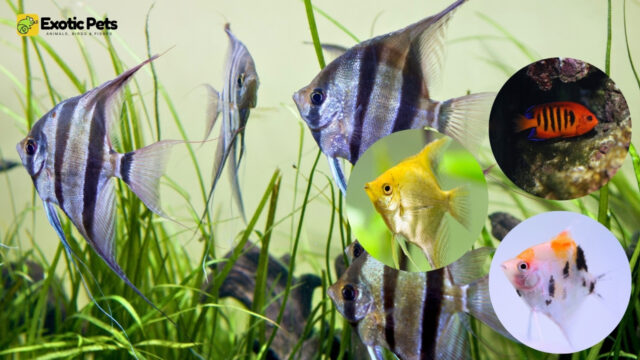
Who wouldn’t want a vibrant and elegant fish like the angelfish gracing their freshwater aquarium? Angelfish (Pterophyllum), a popular choice among aquarium enthusiasts, are tropical fish known for their distinctive appearance and graceful swimming patterns. Angelfish belong to the cichlid family and come in various types and colors, making them a favorite for many aquarists.
Whether you’re a seasoned aquarist or a beginner, understanding the different types of angelfish available is crucial for creating a thriving aquatic environment. This comprehensive guide will explore the various types of angelfish, highlighting their unique characteristics, care requirements, and compatibility with other fish. Why is this important? Understanding the specific needs of each angelfish type ensures a thriving and harmonious aquarium environment.
Angelfish Origins: When and Where Did They Emerge
Angelfish originate from the freshwater rivers and streams of South America, specifically the Amazon Basin, Orinoco Basin, and various river systems in the Guiana Shield. Their natural habitats provide clues to their care requirements in captivity. Their popularity in the aquarium hobby soared in the mid-20th century, and they’ve remained a staple ever since. Today, through selective breeding, a dazzling array of angelfish varieties exists, each boasting distinct characteristics and captivating aesthetics.
Species Types of Angelfish
There are primarily three freshwater angelfish species Known in the aquarium market:
- Pterophyllum scalare – Common Angelfish.
- Pterophyllum altum – Altum Angelfish.
- Pterophyllum leopoldi – Leopold Angelfish.
1. Pterophyllum Scalare
The most common and widely recognized type of angelfish is the Pterophyllum scalare. Known for their striking appearance, these angelfish come in various color morphs, including silver, zebra, and koi.
2. Pterophyllum Altum
Pterophyllum altum, commonly known as the altum angelfish or Orinoco angelfish, is renowned for its tall, elongated dorsal and anal fins. These angelfish are larger and more delicate compared to Pterophyllum scalare.
- Appearance: Altum angelfish have a silver body with vertical dark stripes and a distinctive “notch” between their dorsal and body. Their fins are long and gracefully flowing.
- Care Requirements: Due to their specific water parameter needs, altum angelfish is recommended for experienced aquarists. They thrive in soft, acidic water with a pH range of 4.8 to 6.2 and temperatures between 82°F to 88°F (28°C to 31°C).
3. Pterophyllum Leopoldi
Pterophyllum leopoldi, or Leopold’s angelfish, is the least common and smallest species of freshwater angelfish. Despite their smaller size, they exhibit a distinct charm and personality.
- Appearance: Leopold’s angelfish are often mistaken for juvenile Pterophyllum scalare due to their similar body shape. However, they have a more rounded body and lack the notch seen in altum angelfish. They display a silver body with fewer and broader vertical stripes.
- Care Requirements: These angelfish are hardy and adaptable, making them suitable for both beginners and experienced aquarists. They prefer slightly acidic to neutral water with a pH range of 6.0 to 7.4 and temperatures between 76°F to 82°F (24°C to 28°C).
Common Types of Freshwater Angelfish
1. Silver Angelfish (Pterophyllum scalare)
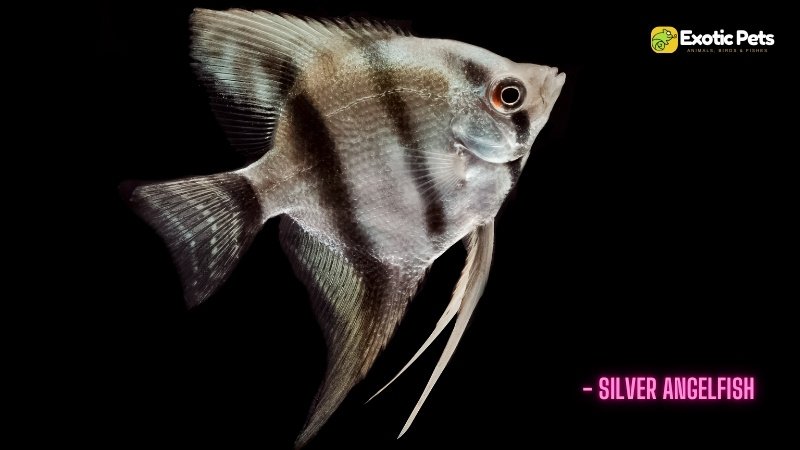
- Origin: Amazon Basin, South America
- Appearance: Shimmering silver body with three prominent black vertical stripes.
- Size: Up to 6-7 inches in length.
- Lifespan: With proper care, silver angelfish can live for ten years or more.
A timeless classic, the Silver Angelfish is a direct descendant of its wild ancestors. Their shimmering silver scales are adorned with three bold, vertical black stripes, evoking the image of angelfish gliding through the Amazon’s waters. Reaching up to 7 inches in length, these hardy and adaptable fish are an excellent choice for beginners and experienced aquarists alike. Their unassuming beauty and ease of care make them a beloved staple in the aquarium hobby.
2. Zebra Angelfish
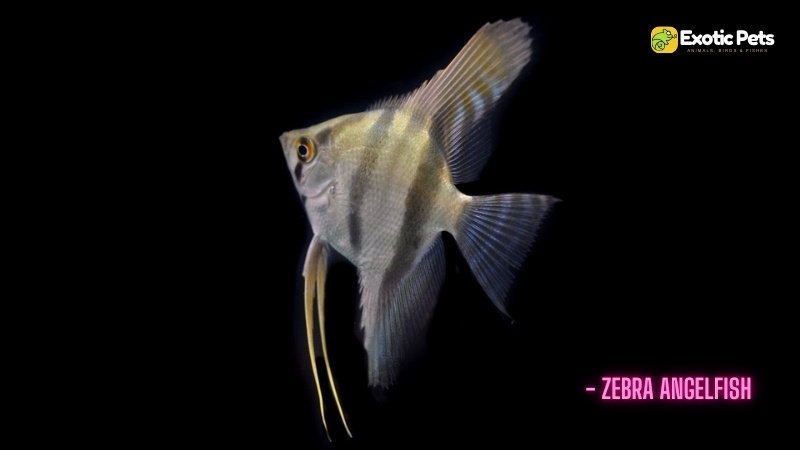
- Origin: Amazon Basin, South America (selectively bred variety)
- Appearance: Silver/white body with numerous bold, black vertical stripes.
- Size: Up to 6-7 inches in length.
- Temperament: Generally peaceful but can display territorial behavior, especially during breeding.
The Zebra Angelfish is a captivating variation of the classic silver angelfish, renowned for its dramatic black and white striped pattern. Unlike its silver counterpart, the Zebra Angelfish boasts an intensified pattern with an increased number of black stripes that run vertically across its body. This striking appearance resembles the iconic stripes of a zebra, giving the fish its fitting name.
3. Gold Angelfish
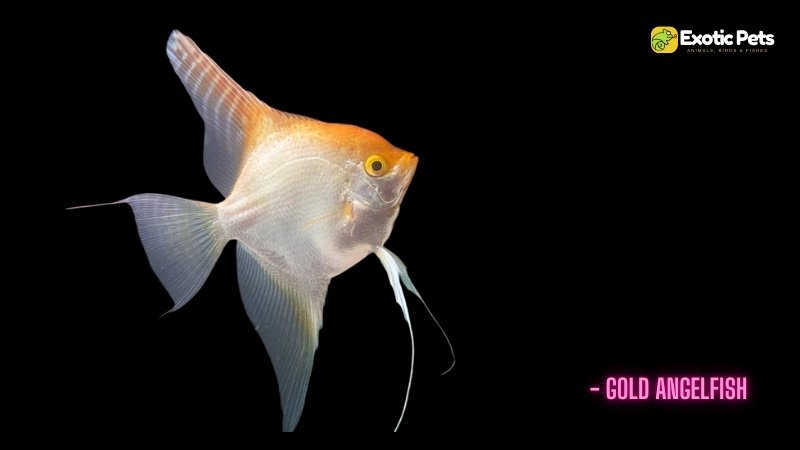
- Origin: Amazon Basin, South America (selectively bred variety)
- Appearance: Gleaming gold or yellow body with subtle black markings.
- Size: Up to 6-7 inches in length.
- Temperament: Generally peaceful but can become territorial during breeding.
The Gold Angelfish is a radiant variation of the classic Silver Angelfish, renowned for its captivating golden or yellowish hues. Unlike its silver counterpart, the Gold Angelfish boasts a warmer, more vibrant coloration that ranges from pale yellow to deep gold, often adorned with subtle black markings on its fins and body. This elegant and eye-catching appearance makes it a sought-after addition to many aquariums.
4. Koi Angelfish
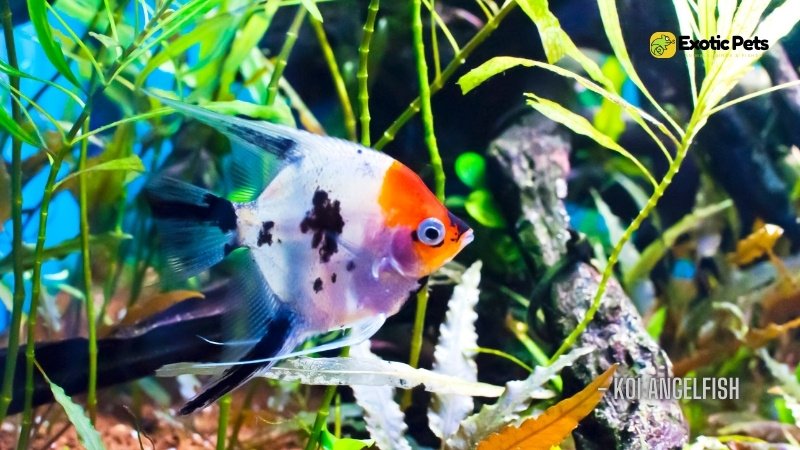
- Origin: Amazon Basin, South America (selectively bred variety)
- Appearance: A captivating mix of orange, red, black, and white markings on a silver or gold base.
- Size: Up to 6-7 inches in length.
- Temperament: Generally peaceful but can display some territoriality, particularly during breeding.
The Koi Angelfish is a mesmerizing spectacle of color reminiscent of the revered Koi carp. Its captivating pattern blends a mix of vibrant orange, red, black, and white, creating a truly unique and eye-catching display. Each Koi Angelfish boasts its own distinct pattern, making every individual a living work of art.
5. Marble Angelfish
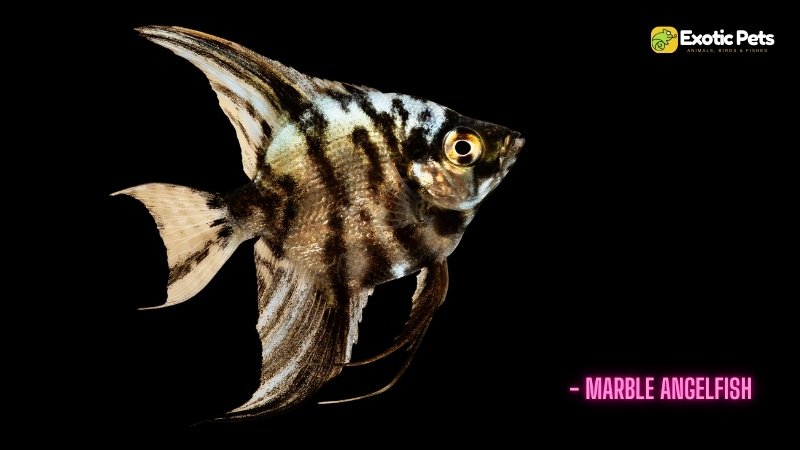
- Origin: Amazon Basin, South America (selectively bred variety)
- Appearance: Unpredictable marbled pattern with varying shades of black, white, gold, or silver.
- Size: Up to 6-7 inches in length.
- Temperament: Generally peaceful, though can exhibit territorial behavior, especially during breeding.
The Marble Angelfish is a captivating canvas of swirling patterns, showcasing a unique blend of black, white, and sometimes even gold or silver. No two Marble Angelfish are alike, with each fish boasting its own distinct marbled design. This unpredictable beauty makes them a sought-after addition to aquariums, offering a touch of artistic whimsy to any aquatic setting.
6. Black Angelfish
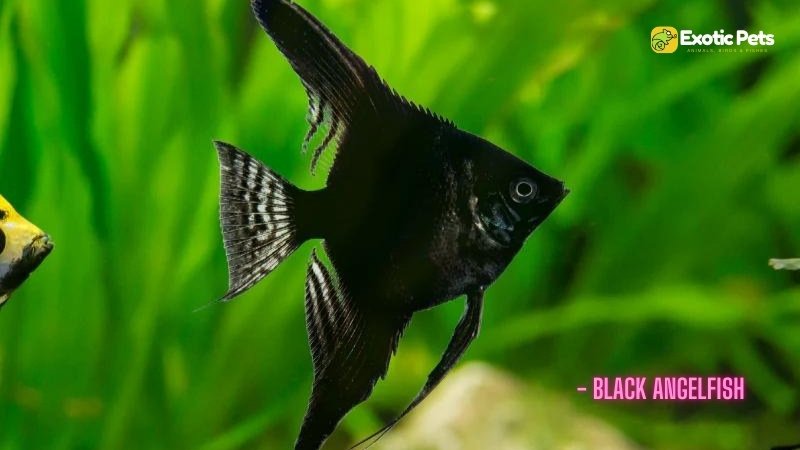
- Origin: Amazon Basin, South America (selectively bred variety)
- Appearance: Deep black body and fins, sometimes with a subtle iridescent sheen.
- Size: Up to 6-7 inches in length.
- Temperament: Generally peaceful but can exhibit territorial behavior, particularly when breeding.
The Black Angelfish is an enigmatic beauty cloaked in velvety darkness that exudes both mystery and allure. Unlike its brightly colored counterparts, the Black Angelfish boasts a deep, rich black coloration that extends across its body and fins. This striking appearance makes it a captivating centerpiece in any aquarium, creating a dramatic contrast against lighter-colored tank mates.
7. Veiltail Angelfish
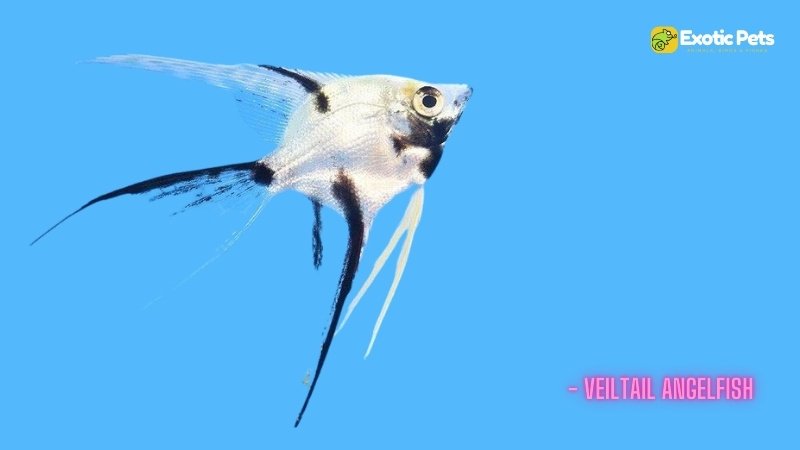
- Origin: Amazon Basin, South America (selectively bred variety)
- Appearance: Long, flowing fins that extend beyond the body, available in various colors and patterns.
- Size: Up to 6-7 inches in length (with fins included).
- Temperament: Generally peaceful, but their delicate fins can make them susceptible to fin-nipping from more boisterous tank mates.
The Veiltail Angelfish is an ethereal beauty known for its long, flowing fins that gracefully trail behind it like a delicate veil. This dramatic finnage is a result of selective breeding, amplifying the natural elegance of the angelfish fins into a breathtaking display. Veiltail Angelfish comes in a variety of colors and patterns, adding to their allure.
8. Albino Angelfish
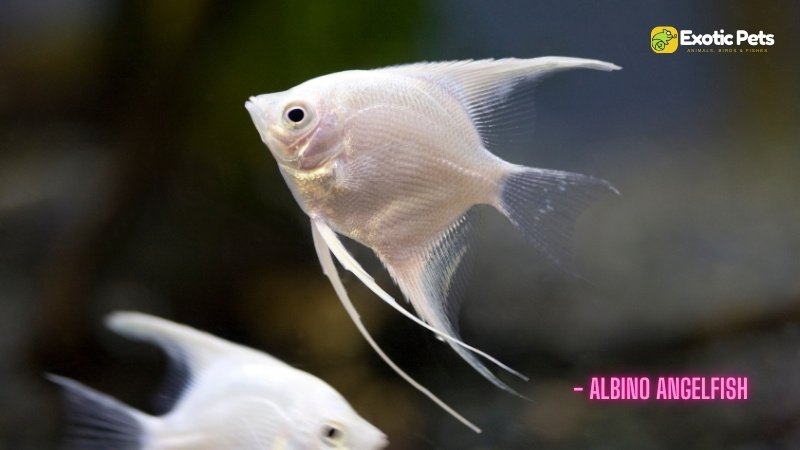
- Origin: Amazon Basin, South America (selectively bred variety)
- Appearance: Pure white body with red or pink eyes.
- Size: Up to 6-7 inches in length.
- Temperament: Generally peaceful but can display territorial behavior, particularly during breeding.
- Sensitivity to Light: Albino angelfish are more sensitive to light due to their lack of pigmentation. It’s important to provide them with ample shade and subdued lighting.
The Albino Angelfish is a striking anomaly in the world of angelfish, captivating with its pure white body and mesmerizing red or pink eyes. This unique coloration is a result of a genetic mutation that prevents the production of melanin, the pigment responsible for dark colors. The result is a fish that exudes an ethereal beauty and stands out in any aquarium setting.
9. Blushing Angelfish
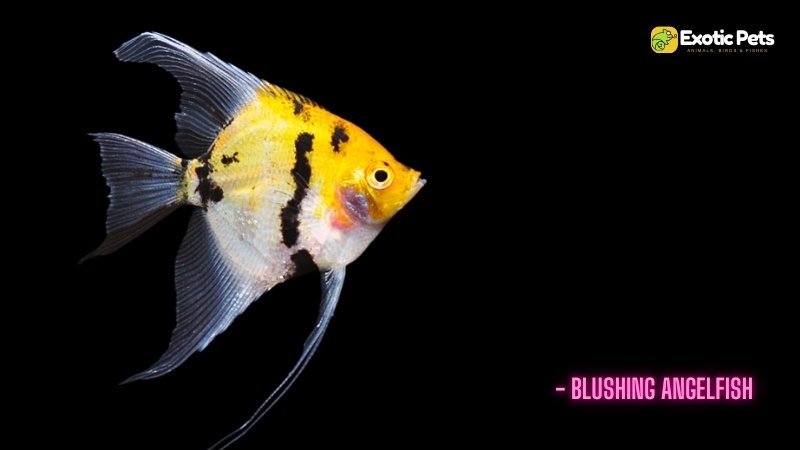
- Origin: Amazon Basin, South America (selectively bred variety)
- Appearance: Silver or gold body with a soft, pinkish-orange blush on the gill covers and belly.
- Size: Up to 6-7 inches in length.
- Temperament: Generally peaceful but can exhibit territorial behavior, especially during breeding.
The Blushing Angelfish is a subtle yet captivating variety, distinguished by its soft, pinkish-orange blush that graces its gill covers and belly. This delicate flush of color creates a charming and romantic appearance, setting the Blushing Angelfish apart from its more boldly patterned counterparts.
10. Smokey Angelfish
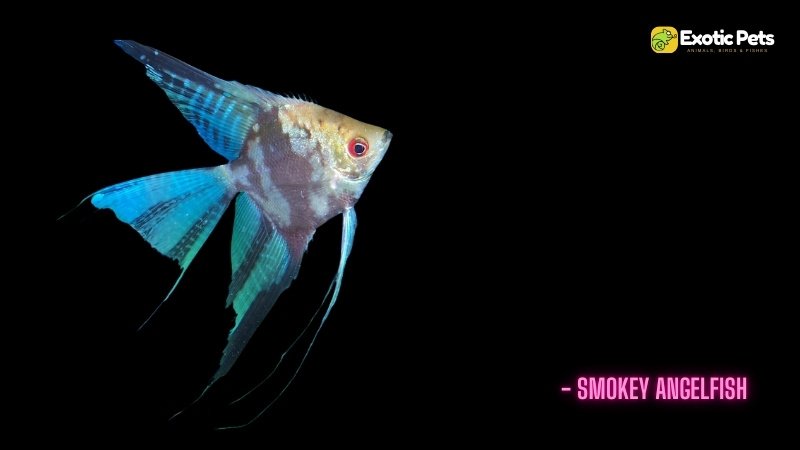
- Origin: Amazon Basin, South America (selectively bred variety)
- Appearance: Silver body with a smoky gray or black overlay that partially obscures the scales and stripes.
- Size: Up to 6-7 inches in length.
- Temperament: Generally peaceful but can display territorial behavior, especially during breeding.
The Smokey Angelfish is a captivating variation of the classic silver angelfish, renowned for its subtle yet striking coloration. Unlike its more brightly colored counterparts, the Smokey Angelfish boasts a dusky, smoky gray overlay that partially obscures its underlying silver scales and black stripes. This unique coloration can vary in intensity, ranging from a light haze to a deeper, more pronounced smokiness.
11. Halfblack Veil Angelfish
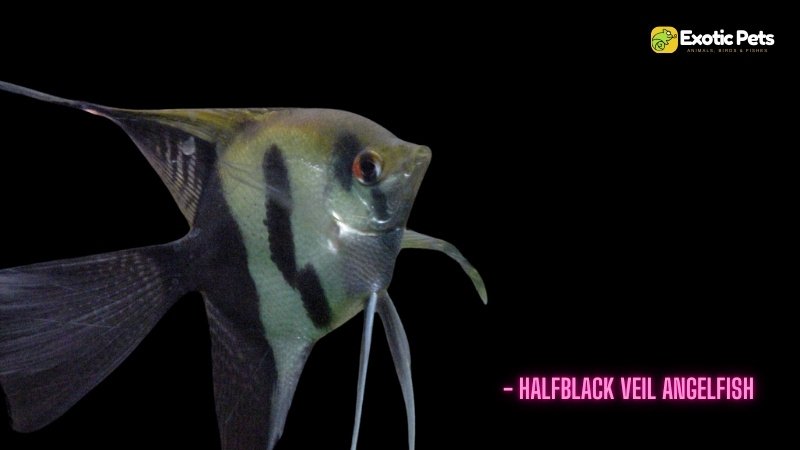
- Origin: Amazon Basin, South America (selectively bred variety)
- Appearance: The front half is silver/white, and the back half is black, with long, flowing veil fins.
- Size: Up to 6-7 inches in length (with fins included).
- Temperament: Generally peaceful but can display territorial behavior, particularly when breeding.
- Fin Care: As with all veil angelfish, their delicate fins require special care to avoid damage.
The Half-Black Veil Angelfish is a truly unique and eye-catching variety, showcasing a striking split coloration. The front half of its body is typically a shimmering silver, while the back half is a deep, velvety black. Adding to its dramatic appearance are the elongated, flowing fins characteristic of all veil angelfish varieties. As the fish matures, its black coloration often deepens and intensifies, creating an even more striking contrast.
12. Gold Pearlscale Angelfish
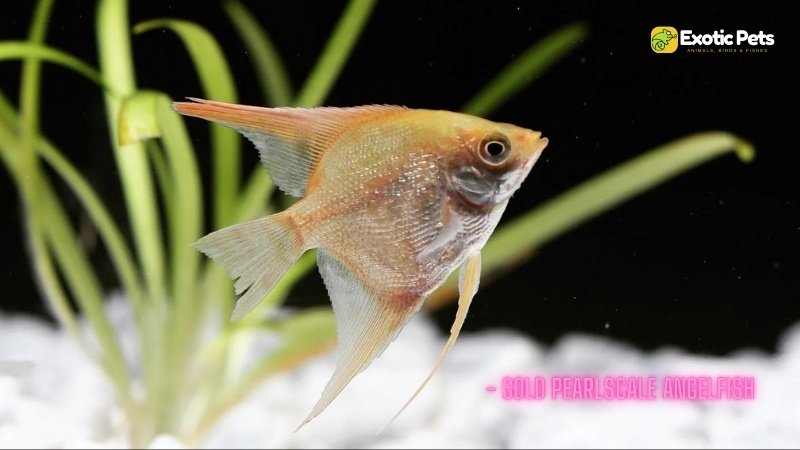
- Origin: Amazon Basin, South America (selectively bred variety)
- Appearance: Golden body with iridescent, pearlescent scales that shimmer and sparkle.
- Size: Up to 6-7 inches in length.
- Temperament: Generally peaceful but can display territorial behavior, especially during breeding.
- Scale Care: The pearlescent scales are delicate and require gentle handling to avoid damage.
The Gold Pearlscale Angelfish is a dazzling spectacle, adorned with iridescent scales that shimmer and sparkle like precious pearls. Unlike its smooth-scaled counterparts, the Gold Pearlscale Angelfish has scales with a raised, textured surface that reflects light, creating a mesmerizing display of iridescence. Its base color is a rich, lustrous gold, further amplified by the shimmering effect of its scales.
13. Ghost Angelfish
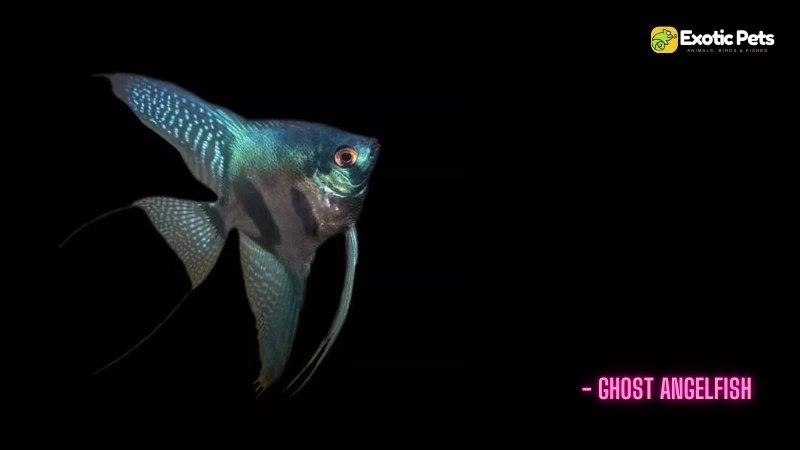
- Origin: Amazon Basin, South America (selectively bred variety)
- Appearance: Translucent or semi-translucent body with faint stripes.
- Size: Up to 6-7 inches in length.
- Temperament: Generally peaceful but can display territorial behavior, especially during breeding.
The Ghost Angelfish is an ethereal presence in the aquarium, known for its almost translucent body and faint, barely visible stripes. This unique appearance is due to a lack of dark pigmentation, resulting in a pale, ghostly hue that can range from silvery-white to faint gold. Their eyes, however, remain dark, adding a touch of contrast to their otherwise ethereal form.
14. Altum Angelfish
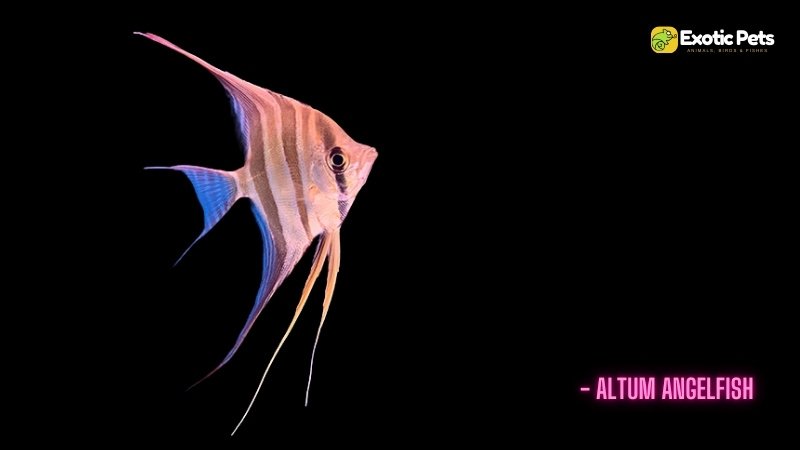
- Origin: Orinoco River Basin and Upper Rio Negro watershed in South America
- Appearance: Silver body with vertical black stripes, dramatically elongated dorsal and anal fins, and a pronounced forehead.
- Size: Up to 12-16 inches in height, making them significantly larger than other angelfish species.
- Temperament: Generally peaceful, but can display territorial behavior, particularly during breeding.
- Care Level: Intermediate to advanced, requires specific water parameters and a large aquarium.
The Altum Angelfish stands as a testament to the grandeur of the Amazonian wilderness. Renowned for its impressive size and dramatically elongated fins, this magnificent fish is a true showstopper in any aquarium. With a distinct, high-bodied profile and a pronounced forehead, the Altum Angelfish exudes an air of regal elegance that sets it apart from its smaller, more common relatives.
15. Leopold Angelfish
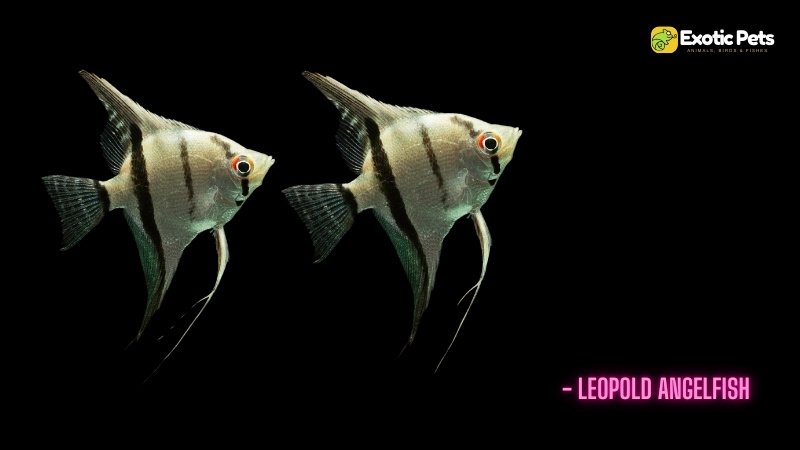
- Origin: Amazon River basin, particularly the Solimões River and Rupununi River.
- Appearance: Silver body with up to 11 thin vertical stripes and a distinctive black spot on the head. Mature individuals develop red or maroon hues in their dorsal and pectoral fins.
- Size: Up to 4 inches in length, making it one of the smallest angelfish species.
- Temperament: Generally peaceful, but can become territorial, especially during breeding.
- Care Level: Intermediate to advanced due to its sensitivity and specific water requirements.
The Leopold Angelfish, also known as the Teardrop or Dwarf Angelfish, is a captivating species that stands out with its petite stature and distinctive features. Unlike its larger cousins, the Leopold Angelfish showcases a more compact body shape, reaching a maximum length of just about 4 inches. Its most striking feature is the prominent black spot on its head, which sits just above the gill cover, giving it a teardrop-like appearance. This, combined with its numerous thin vertical stripes (up to 11!), sets it apart from other angelfish varieties.
Freshwater vs. Saltwater Angelfish (Marine Angelfish)
Freshwater angelfish, primarily of the genus Pterophyllum, hail from the Amazon Basin. Their popularity surged in the mid-20th century, and today, selective breeding has produced a dazzling array of colors and patterns. Marine angelfish, on the other hand, belong to the family Pomacanthidae and inhabit coral reefs across the globe. They boast vibrant colors and intricate patterns that have evolved to aid in camouflage and communication.
While both freshwater and saltwater angelfish are known for their wing-like fins and elegant profiles, several key differences in genetics, anatomy, tank requirements, and behaviors set them apart. Understanding these differences is crucial for any aquarist looking to care for these beautiful fish.
| Feature | Freshwater Angelfish | Saltwater Angelfish (Marine Angelfish) |
|---|---|---|
| Habitat | Amazon Basin, slow-moving rivers | Coral reefs |
| Diet | Omnivorous (flakes, pellets, live/frozen foods) | Carnivorous (sponges, invertebrates, algae) |
| pH Range | 6.5 to 7.5 | 8.1 to 8.4 |
| Temperature Range | 76°F to 82°F (24°C to 28°C) | 72°F to 78°F (22°C to 26°C) |
| Salinity | Freshwater | 1.020 to 1.025 specific gravity |
| Filtration | Standard freshwater filtration | Advanced filtration with protein skimmers, live rock |
| Behavior | Consistent appearance, varied behaviors | Significant appearance changes as they mature |
| Tank Mates | Compatible with peaceful freshwater fish | Compatible with non-aggressive saltwater species |
| Tank Size | Minimum 20 gallons for a pair | Minimum 55 gallons, larger for adult specimens |
Care and Maintenance of Angelfish
Ensuring the health and longevity of angelfish in a freshwater aquarium involves understanding their specific care requirements and maintaining optimal water conditions. Here are some essential tips for angelfish care:
Aquarium Setup: Angelfish requires a spacious aquarium due to their size and active swimming habits. A minimum tank size of 20 gallons is recommended for a pair, with larger tanks needed for groups. Maintain stable water conditions with a pH range of 6.5 to 7.5 and temperatures between 76°F to 82°F (24°C to 28°C). Regular water changes and a reliable filtration system are crucial to keep the water clean and healthy. Provide a well-planted aquarium with plenty of hiding spots and swimming space. Live plants like Amazon swords, java ferns, and anubias are ideal for creating a natural environment.
Diet and Feeding: Angelfish are omnivores and thrive on a varied diet. Offer high-quality flake or pellet food as the staple diet, supplemented with live or frozen foods such as brine shrimp, bloodworms, and daphnia. Feed angelfish small amounts of food two to three times a day. Avoid overfeeding, as uneaten food can lead to poor water quality.
Tank Mates: Choose tank mates carefully to avoid aggression and stress. Suitable tank mates include tetras, rasboras, corydoras, and peaceful cichlids. Avoid fin-nipping species and overly aggressive fish. Monitor the behavior of angelfish and their tank mates regularly. If aggression or bullying occurs, be prepared to separate the fish to maintain a harmonious environment.
Also Read: 13 Common Angelfish Diseases and Illnesses With Treatment
Conclusion
Selecting the right type of angelfish for your freshwater or saltwater aquarium involves understanding their specific care requirements and compatibility with other fish. Whether you opt for the classic silver angelfish or the exotic altum angelfish, each variety brings its unique charm and beauty to your tank.
By providing a well-maintained environment, a balanced diet, and suitable tank mates, you can enjoy the captivating presence of angelfish in your aquarium for years to come. Their graceful movements and vibrant colors make them a rewarding addition for both novice and experienced aquarists.
Let me know if you’d like a deeper dive into any of these angelfish varieties, their specific care requirements, or tank setup tips!

